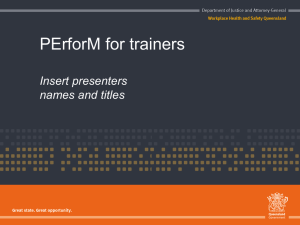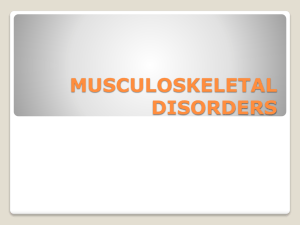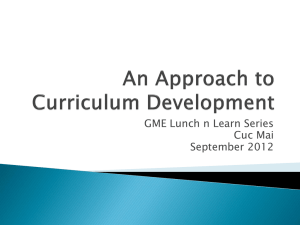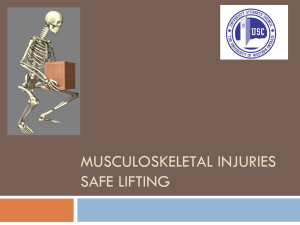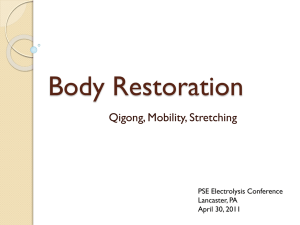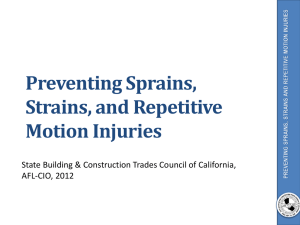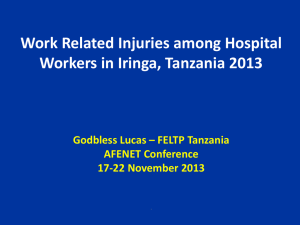Prevention of MSDs from performing manual tasks in mining
advertisement
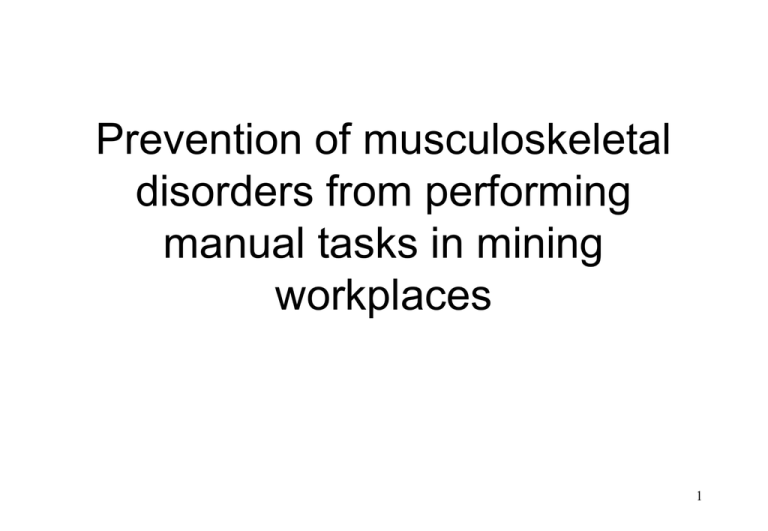
Prevention of musculoskeletal disorders from performing manual tasks in mining workplaces 1 Overview of the workshop • Aim and learning outcomes of the workshop • Definitions • Injuries from performing manual tasks – mechanism and statistics • Legislative responsibilities • Anatomy and biomechanics • The risk management process applied to manual tasks • Who’s responsible • Case studies • Conclusion and questions 2 Aim of the workshop To give participants the knowledge and skills to identify hazardous manual tasks and to assess and control risks arising from those tasks. This workshop will assist workplaces to fulfil their legislative responsibility to protect employees from hazardous manual tasks. 3 Learning outcomes • Provide the definition of a manual task, a hazardous manual task and a musculoskeletal disorder • Explain the legislative requirement to manage the risk resulting from hazardous manual tasks • Explain how performing manual tasks can lead to injury • Have an understanding of anatomy and biomechanical principles • Participate effectively in the risk management process applied to manual tasks including: – Recognising hazardous manual tasks – Assessing the risk of injury, the source of the risk and the severity of the risk – Developing risk controls to effectively reduce the risk by altering the source of the risk identified in the risk assessment process. 4 Definitions Manual task is a label given to any activity that requires a person to use their physical body (musculoskeletal system) to perform work. This includes work that involves the use of force for: Lifting/lowering; pushing/pulling; carrying; moving; holding; or restraining anything and work that involves: Repetitive actions; sustained postures; and concurrent exposure to vibration 5 Examples of manual tasks 6 Definitions continued Hazardous manual tasks refer to any manual tasks that involve certain characteristics that increase the risk of injury, including: Repetitive or sustained application of force Repetitive or sustained awkward postures Repetitive or sustained movements Application of high force Exposure to sustained vibration Involve handling of person or animal Involve handling of unstable or unbalanced loads that are difficult to grasp or hold 7 Definitions continued Hazardous manual tasks can lead to a variety of injuries and conditions collectively referred to as musculoskeletal disorders (MSD) including: Sprains and strains of muscles, ligaments and tendons Back injuries, including damage to the muscles, tendons, ligaments, spinal discs, nerves, joints and bones Joint injuries or degeneration, including injuries to the shoulder, elbow, wrist, hip, knee, ankle, hands and feet Bone injuries Nerve injuries Muscular and vascular disorders as a result of hand-arm vibration Soft tissue hernias 8 Injuries from performing manual tasks Injuries occur when forces on structures of the musculoskeletal system (e.g. muscle, ligaments, tendon, bone) are greater than the structures can withstand • Acute injuries – sudden damage to musculoskeletal system, occurs as consequence of single exposure to high force • Cumulative injuries – cumulative wear and tear on musculoskeletal system, caused by repeated or prolonged exposure to lower levels of force 9 Extent and cost of injuries in WA mining Injuries from performing manual tasks consistently account for about 1/3 of all new LTIs and DIs and over 50% of all injury recurrences About 2/3 of these LTIs and DIs and 90% of these recurrences are serious (14 or more days/shifts lost) These injuries account for nearly 40% of all LTI compensation costs and approximately 45% of the total days lost from workplace injuries. LTI Lost time injury, requiring absence from work for a full shift DI Disabling injury, unable to work usual job any time of shift/alternate duties Sources: AXTAT data 2004-2007 and WorkerCover data 2005-2007 Source: Workers' Compensation Statistical Report 1998/9 - 2001/02 10 Overview of legislation • Resources Safety administers the Mines Safety and Inspection Act 1994 (MSI Act) and the Mines Safety and Inspection Regulations 1995 (MSI Regulations) • The MSI Act sets out broad duties with respect to OSH, supported by MSI Regulations • Codes of practice and guidelines provide practical guidance 11 Duties – Employers* Employers have a general duty to provide and maintain a working environment to protect the health and safety of their workforce including a requirement to: – Provide and maintain workplaces, plant and systems of work – Provide information, instructions, training and supervision – Consult and cooperate with safety and health representatives and employees so that employees are not exposed to hazards. *Employer is anyone who employs a person in a mining operation. 12 Duties – Employees* Employees are obliged to take reasonable care to ensure their own and others’ safety and health including a requirement to: – Cooperate with employers – Follow instructions – Report hazards *Employees include contract and labour hire personnel 13 Legislative requirement • If a hazardous manual task is identified, all duty holders must fulfil their obligations to reduce the risk of injury to workers completing the task • Risk management process is recommended to fulfil obligations – hazard identification – risk assessment – risk control – control evaluation 14 Overview of anatomy and biomechanics • • • • Anatomy of the spine Body positions and postures Types of muscle work Principles of biomechanics 15 Anatomy of the spine 16 Trunk (back) positions Flexion and extension 17 Trunk (back) positions Side flexion and rotation 18 Wrist positions Extension, neutral and flexion 19 Hand and forearm positions Pronation and supination 20 Neutral postures • Head and neck – level or bent slightly forward, forward facing, balanced and in-line with the trunk • Hands wrists and forearms – all straight and in-line • Elbows – close to the body and bent 90o to 120o • Shoulders – relaxed and upper arms hang normally at the side of the body 21 Neutral postures continued • Thighs and hips – parallel to the floor when sitting; perpendicular to the floor when standing • Knees – same height as hips with feet slightly apart when sitting; aligned with hips and ankles when standing • Back – vertical or leaning slightly back with lumbar support when sitting; vertical with an S-shaped curve when standing Source: NIOSH IC 9509: Ergonomics Processes Implementation Guide and Tools for the Mining Industry 22 Types of muscle work • Dynamic Muscle contraction and movement • Static Muscle contraction and no movement 23 Principles of biomechanics 24 Using the spine as a crane 25 Risk management process Source: National Code of Practice for the Prevention of Musculoskeletal Disorders from Performing Manual Tasks at Work 26 Overview of hazard identification Hazard identification is a way of analysing tasks to find out which tasks cause or contribute to musculoskeletal disorders. That is, a process to identify hazardous manual tasks. Check sources of information such as injury and hazard reports Consult with workers, supervisors and safety and health representatives Look at task and identify any of the characteristics that make it hazardous 27 Reporting hazardous manual tasks • All personnel at mining workplaces have a statutory obligation to report hazards • Being proactive by early reporting of concerns such as discomfort, pain, when completing a manual task may prevent serious injury Source: NIOSH IC 9497: Ergonomics and Risk Factor Awareness Training for Miners 28 Example of hazard identification form Source: Burgess-Limerick, R (2009) Procedure for Managing Injury Risks Associated with Manual Tasks 29 Example of discomfort survey form Source: National Code of Practice for the Prevention of Musculoskeletal Disorders from Performing Manual Tasks at Work 30 Potentially hazardous manual tasks Research suggests a manual task should be considered potentially hazardous if any of the following apply: • An injury (musculoskeletal disorder) has been recorded that was associated with performance of the task • Any employee is physically incapable of performing the task, or the task can only be done for a short time • Any employee reports discomfort associated with the manual task • Employees have improvised controls for the task Burgess-Limerick (2008) Procedure for Managing Injury Risks Associated with Manual Tasks 31 Potentially hazardous manual tasks continued • Employees doing this task have a higher turnover, or rate of sick leave, than elsewhere in the organisation • The mass of any object, person, or animal being handled exceeds 16 kg • If the force exerted on any object, person or animal exceeds 200 N • If the postures adopted to perform the task involve substantial deviations from neutral Burgess-Limerick (2008) Procedure for Managing Injury Risks Associated with Manual Tasks 32 Potentially hazardous manual tasks continued • If the task involves static postures held for longer than 30 secs and the task is performed for more that 30 mins without a break, or for more than 2 hrs per shift • If the task involves repetitive movements of any body part and is performed for more than 30 mins without a break, or for more than 2 hrs per shift • If the task is performed for longer than 60 mins at a time without a break • If the task is performed for longer than 4 hrs per shift • If exposure to whole body vibration (vehicles) or peripheral vibration (power tools) exceeds 2 hrs per shift Burgess-Limerick (2008) Procedure for Managing Injury Risks Associated with Manual Tasks 33 Overview of risk assessment Risk assessment is about understanding the problem. The risk assessment determines: • whether the task poses or increases risk of injury (musculoskeletal disorder) • source/s (underlying/root cause/s) of the risk • the severity (level) of risk 34 Risk factors • Direct risk factors: Risk factors that are known to lead to musculoskeletal disorders are: – Postures and movements of worker – Forces (exertion) involved in task – Duration and frequency of task • Indirect risk factors: Risk factors that are known to contribute to the risk of musculoskeletal disorders are: – Work environment – Systems of work, work organisation and work practices – Exposure to vibration • The risk of developing a musculoskeletal disorder significantly increases where there is more than one risk factor present in the task 35 Risk factors: postures and movements If a task involves postures and movements that are: • repetitive (more than twice a minute) or • sustained (more than 30 seconds at a time) and/or • awkward (away from the neutral position) then the risk of injury (musculoskeletal disorder) increases 36 Examples of postures and movements that increase the risk of injury • Working with the trunk or neck twisted or bent • Working with hands above shoulder height • Reaching forward or sideways • Reaching or twisting behind the body • Working in kneeling, squatting, crawling or lying • Working with extreme wrist bending or twisting • Working with tight pinch grips • Carrying or exerting force with one hand or on one the side of the body • Working in a static (held) position • Exerting force while in an awkward posture • Repetitive lifting, lowering, carrying, pushing, pulling, restraining, holding Photograph Source: NIOSH IC 9497: Ergonomics and Risk Factor Awareness Training for Miners 37 Risk factors: force • A manual task that involves high force is one that people in the working population would find difficult because of the effort it requires • Where there are high forces involved in the task, even if they are not repetitive or sustained, there can be a risk of injury. • The risk in tasks involving high force is related to: – the intensity of the force – the speed of the force – whether the force is jerky or sudden Photograph Source: NIOSH IC 9497: Ergonomics and Risk Factor Awareness Training for Miners 38 Risk factors: duration and frequency • Tasks that continue over a long period or are repeated over the work day, increase the worker’s exposure • Risk of injury is influenced by: – how long the task is carried out (duration); and – how often the task is done (frequency) Photograph Source: NIOSH IC 9497: Ergonomics and Risk Factor Awareness Training for Miners 39 Risk factors: work environment Aspects of the work environment that can contribute to the risk of injury when performing manual tasks include: Thermal environment – cold, heat, humidity and wind Workplace lighting – low levels of light, glare Floor surfaces – slippery, uneven, variation in levels Housekeeping – obstructions, trip hazards 40 Risk factors: work systems, organisation and practices Aspects of the work organisation, work practices and systems of work that may increase the risk of injury include: – pace of work and time constraints – abilityof workers to influence workload or work methods – level of resources and guidance available 41 Risk factors: vibration • The longer a worker undertaking manual tasks is exposed to vibration, the greater the risk of a musculoskeletal disorder • Workers may be exposed to two types of vibration: – Whole-body vibration – Hand-arm vibration 42 Source of risk Determining the source (i.e. underlying cause) of the risk/s in a hazardous manual task is an important part of the risk assessment Sources of risk include: – Work area design and layout – Nature of load being handled – Nature of the items (including hand tools, plant and equipment) – Working environment (including thermal environment, floor or ground surfaces, obstructions, lighting, noise and vibration) – Systems of work, work organisation, work practices 43 Severity of risk Determining the severity of the risk helps to prioritise hazardous manual tasks for action 44 Example of risk assessment checklist Copyright 2007-2008 Burgess-Limerick & Associates www.burgess-limerick.com 45 Overview of risk control • Risk control means implementing effective measures to eliminate or minimise risk of injury (musculoskeletal disorders). • Risk control process determines what needs to be done to alter the sources (underlying causes) of risk identified by the risk assessment, in order to eliminate or minimise the risk of injury. • Control measures should follow the hierarchy of controls. Elimination or redesign/engineering controls should be implemented over administrative and PPE controls 46 Approach to risk control Eliminate the hazardous manual task or Redesign the work, workplace or equipment to minimise the risk of injury (musculoskeletal disorders) and Provide appropriate manual task training 47 Risk control: elimination • The ultimate control measure is to eliminate the hazardous manual task • Best practice includes: – Eliminating potential hazardous manual tasks during the design of workplaces, equipment, tools, plant and systems of work – Incorporating ergonomics specifications into purchasing procedures 48 Risk control measures Alter the source (underlying cause) of the risk by altering: • design and layout of the workplace • nature of the load (including using mechanical aids or assistive devices) • nature of the items used during manual tasks (including hand tools) • working environment • work organisation and work practices, including systems of work to minimise the risk of injury (musculoskeletal disorder) as far as is practicable 49 Alter workplace design and layout Location and design of switch changed to reduce reach and allow the operator’s arm to be in a neutral posture Source: NIOSH IC: 9491 Ergonomics and Mining: Charting a Path to a Safer Workplace 50 Alter workplace design and layout Access to wash-plant area changed to reduce awkward postures Source: ACARP Project C11058: Reducing Musculoskeletal Risk in Open Cut Coal Mining 51 Alter workplace design and layout Putting the weighing scale on an elevated cart and locating it next to the conveyor eliminates the need to carry items to the scales and reduces stooping (bending back or trunk) when lifting items on and off the scale Source: NIOSHTIC-2 No. 2003465: Ergonomics Interventions at Badger Mining Corporation 52 Alter nature of the load Attaching a simple handle to this wheel chock improves working posture Source: NIOSH IC 9507 Reducing Low Back Pain and Disability in Mining 53 Alter nature of the load Using mechanical aids or assistive devices reduces manual lifting, lowering, carrying, pushing, pulling and holding Source: NIOSH IC 9507 Reducing Low Back Pain and Disability in Mining 54 Alter nature of the items Suspend heavy tools. The weight of impact wrench is being supported by a strap hung from an overhead crane Source: NIOSH IC: 9491Ergonomics and Mining: Charting a Path to a Safer Workplace 55 Alter nature of the items Use power hand-tools instead of manual hand-tools. Using cable cutters attached to a power drill eliminates repetitive, forceful exertions required to operate manual cable cutters Source: NIOSHTIC-2 No. 2003465: Ergonomics Interventions at Badger Mining Corporation 56 Alter work environment Alter the work environment to reduce the risk of injury (musculoskeletal disorder) by altering the: • thermal environment – reducing and managing exposure to cold, hot, humid and windy conditions • floor surfaces and housekeeping – selecting and maintaining appropriate floor surfaces, steps and ramps and keeping work areas clean, tidy and free of clutter and obstacles • lighting – selecting lighting to suit the task being performed • vibration – controlling exposure to vibration, at the source; and/or the path of the vibration; and/or the vibration received by the worker 57 Alter the work Alter work organisation and work practices, including systems of work, to reduce the risk of injury (musculoskeletal disorder) by: – implementing task rotation – implementing work breaks – altering work rates – changing work methods – reducing shift duration – avoiding peak workloads 58 Training General training for manual tasks risk management • During induction • As part of risk control programme Task-specific training • During induction to the task • Refresher training • When tasks and/or equipment are changed 59 Example of risk control documentation Source: McPhee, B (1993) Ergonomics for the Control of Sprains and Strains in Mining. 60 Monitor and review • Monitoring and reviewing the implemented control measures is essential to ensure their effectiveness and that no new hazards have been introduced • The process should include: – consulting with workers – observing the tasks – monitoring any hazard / incident / injury reports 61 62 Who’s responsible? • Who should be involved? • What consultation is needed? • Should records be kept? 63 Case studies • Work in small groups (2-4 people per group) • If possible get into a group with people with the same job or occupation • Discuss the case study and complete the risk assessment and risk control sections • Report on the major risk factors found in the risk assessment, and the control measures 64 The aim is to reduce the risk of injury (musculoskeletal disorders) from performing manual tasks at work, using the risk management process of: – identifying hazards – assessing risks – controlling risks – monitoring and review 65 References and further information • Resources Safety’s guidance document Implementing an Effective Program to Manage the Risks Associated with Manual Tasks provides a list of references and resources for further information • Visit the Hazardous Manual Tasks page at www.dmp.wa.gov.au/7221.aspx 66
